Tips on replanting, watering and diseases to avoid getting pricked
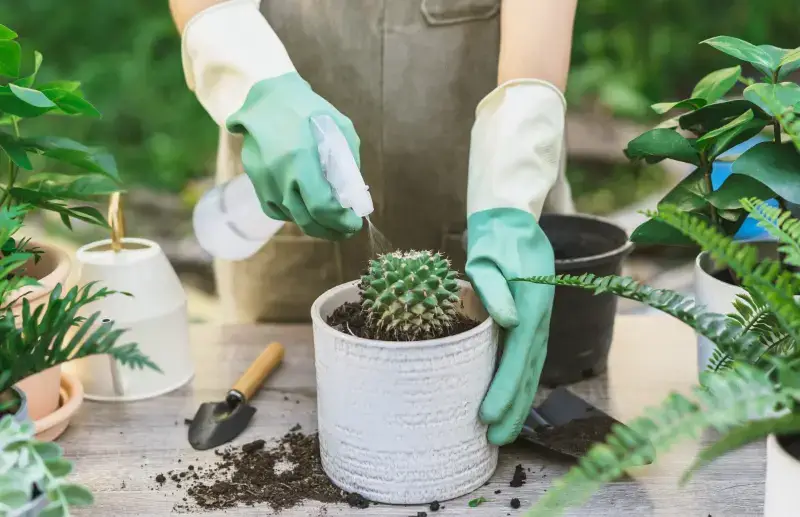
Cactus is an unpretentious plant that requires rare watering and replanting. Indoor types of cacti grow for about ten years. At home, two groups are usually grown: desert and forest.
- Desert cacti. Most often they are represented when talking about this plant. Such cacti have spines and a “fleshy” body.
- Forest cacti (tropical). They resemble succulents, they have softer needles, and there are species with long stems that can intertwine with each other. For example, Decembrist is a forest cactus.
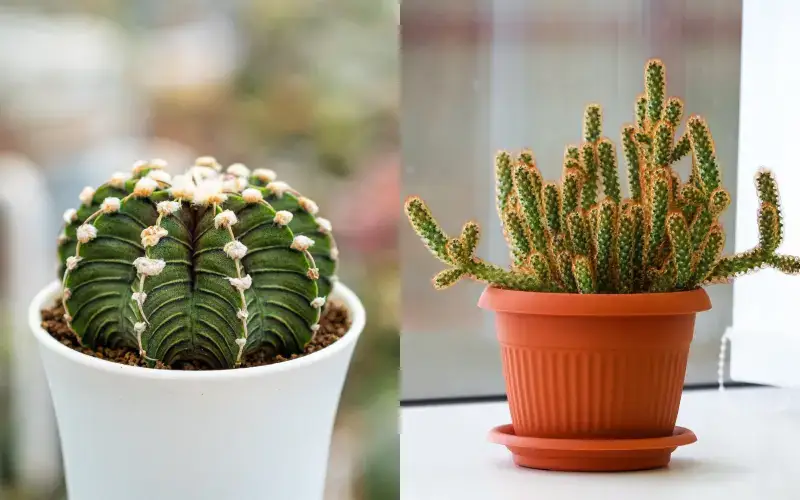
On the left is the desert species Gymnocalycium. On the right – aporocactus, forest species
The most popular indoor types of cacti: mammillaria, astrophytum, epiphyllum echinopsis, rebutia.
RBC Life has compiled detailed instructions on how to care for cacti.
Caring for a cactus at home
Where to put the cactus
Cacti need four to six hours of bright sunlight daily. Some forest species are sensitive to direct rays and may get burned.
It is better to place the cactus in a place where there is diffused light from a window; in winter, you can place the plant on a window facing south or west. In summer, it is permissible to take the cactus out into the fresh air.
Desert cacti are naturally accustomed to fairly cold nights. But a houseplant can be sensitive to temperature changes: do not place the cactus on a window that is constantly open, or in a draft.
In Russia, cacti are often placed near equipment: televisions or computer monitors. It is believed that the plant absorbs harmful radiation, which is why it withers. But most often the reason for the lethargy of a cactus is a lack of sunlight or disease.

Watering a cactus
In spring and summer, the cactus grows actively. Water the plant thoroughly every ten days. In winter, during the dormant period, reduce watering to once every four weeks. The plant’s soil should be dry to the touch.
The watering schedule depends on the type of plant. For example, forest cacti love a little more moisture than desert cacti. It is recommended to spray them with a spray bottle, especially if they begin to wilt.
Water cacti with water at room temperature: cold water can damage the root system.
Fertilizer
The cactus is unpretentious, so you don’t need to fertilize it. Often inexperienced gardeners try to feed the plant with ordinary fertilizer for indoor flowers and only make things worse.
If you decide to fertilize your cactus, look for special products that contain more phosphorus and less nitrogen. The cactus can be fertilized two to three times a year during the growing season.
When does a cactus bloom?
Most house cacti never bloom. It is believed that the gardeners themselves are to blame for this. They create too comfortable conditions for the plant.
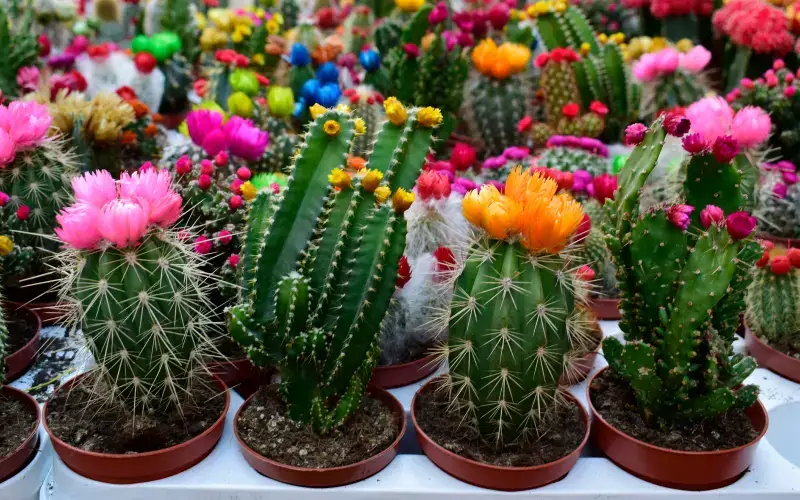
Usually cacti bloom once a year, after a period of hibernation.
In order for the plant to form a bud, you need to create a natural habitat: a warm day and a cool night. In winter, in a state of hibernation, stimulation of flowering usually begins: do not disturb the plant at this time. Most often, cacti bloom in the spring.
Tips for making a cactus bloom:
- create as natural a habitat as possible;
- do not move the plant from place to place;
- Water a little less often;
- The buds form on the shady side of the plant; do not expose them to sunlight, otherwise they will fall off.
Reproduction of indoor cactus
If a cactus has “babies”, they can be used for reproduction. Most of the shoots are found at the base of the plant or along the stem. Removing the «pups» helps the mother plant gain strength and release nutrients into growth.
To collect cuttings, wipe the knife with alcohol and cut at the base at a 45-degree angle. Leave the sprout in a dry place for several days, then plant it in a pot. The new cactus will develop roots in four to six weeks.
How to replant a cactus
Cacti grow slowly and rarely need replanting. Some species begin to bloom only if their roots are “tied” in a pot, so if you want to replant the plant, be prepared that it will take a while to grow.
Cacti are repotted when they need fresh soil or are suffering from rot. Transplantation should be done at the beginning of the growing season, when the plant comes out of hibernation and begins to actively grow. In Russia this is usually the end of February – beginning of March.
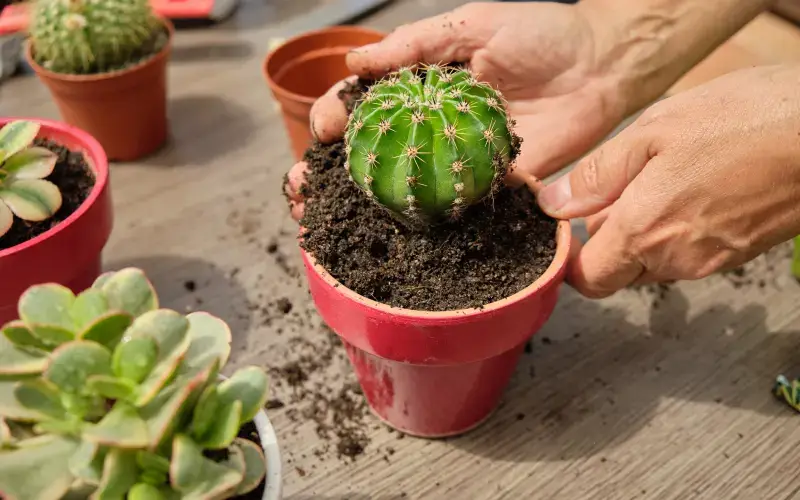
Instructions on how to replant a cactus:
- Stop watering the plant a few days before transplanting.
- Wear protective gloves to make it easier to pick up the prickly cactus.
- Carefully remove the plant from the pot. Be careful not to damage the roots. If the cactus is stuck to the sides of the pot, you can use a spatula to pry up the roots.
- Place the cactus in the new pot so that its neck is level with the rim. Start adding soil evenly from all sides, occasionally tapping the pot. This way you compact the earth.
- Water the cactus a little. Full watering can be done in one to two weeks.
The soil
The soil for any type of cactus should be loose. Leafy and clay-turf soil is ideal. Usually a little sand or perlite is added to it so that it allows more air to pass through. If you are not sure about the quality of the soil, it is better to use a special store-bought mixture for cacti: it contains drainage and peat.
Pot
Choose a new container 1–2 cm larger than the previous one. The shape of the pot will depend on the roots of the plant. If they are long, then it is better to choose a deep, but not wide pot. If the roots are short and grow in different directions, take a wide and shallow container.
Don’t forget to make drainage holes! This is a required item. This way you will avoid water stagnation and root rotting.
Cactus diseases
Cacti are most susceptible to rot and viruses. It is often very difficult to determine the disease; gardeners focus on the appearance of the plant. Any changes in the cactus require stopping watering and treatment.
- Rot. The most important problem with cacti, which occurs most often. Usually occurs due to stagnation of water. If the root system is damaged, the diseased areas should be cut off and the plant replanted. If rot has affected areas on the cactus, cut them out and sprinkle them with crushed coal. Leave the cactus alone until the wounds heal.
- Dry rot. This is a fungal disease. Looks like large rusty or white spots at the base of the cactus. It is better to trim the plants with a knife to healthy tissue and replant.
- Yellow, brown or brown spots. Most likely, viruses or microorganisms did this. It is very difficult to identify the cause and specific pathogen. You can spray the plant with fungicidal preparations.
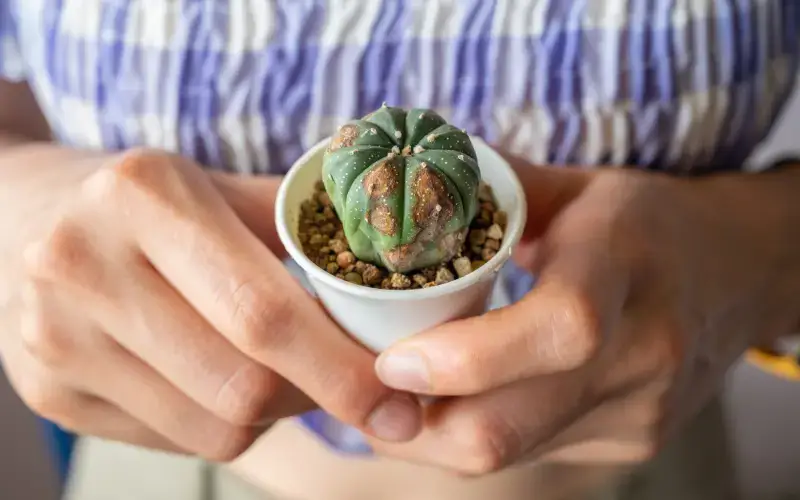
If treatment with mineral components does not help, the disease is most likely incurable
Important: trim the cactus with a sharp knife or scalpel. Disinfect the instrument often, for example, with a cotton pad and alcohol. If even a small part of the “infection” remains on the blade, all your attempts to save the plant are doomed to failure.
Cactus does not grow: what to do
- Leave the cactus alone. Excessive persistence of gardeners only harms the plant. Perhaps your cactus is not growing because you are tired of it with constant fertilizers, watering, and moving it from place to place.
- Replant into a new pot. Perhaps the cactus just doesn’t like the soil. You can try to replant the plant, following the recommendations from the article.
- Reduce watering. You should not overwater the cactus; even in summer, most species need watering once a week.
- Find another place. Lack of light or direct sunlight is harmful to some types of cacti.
- Inspect the cactus for diseases. Any changes or spots on the body of the cactus may indicate that the plant has become infected. It is worth checking the condition of the root system.
- Just wait. If you are sure that the problem is not disease, and that everything is in order with the soil and pot, perhaps the cactus is simply dormant. In winter, there is no need to worry that the cactus does not grow.



